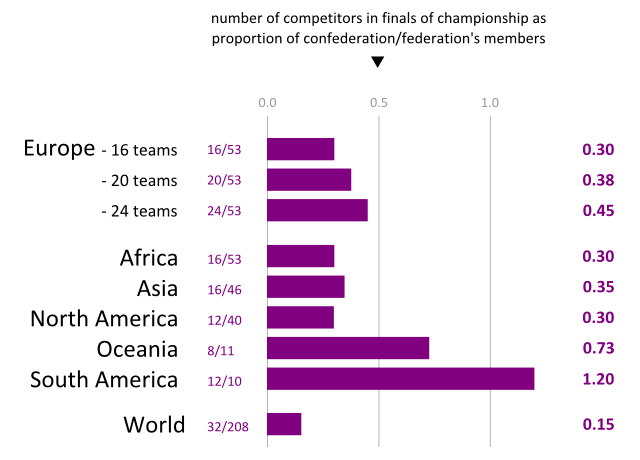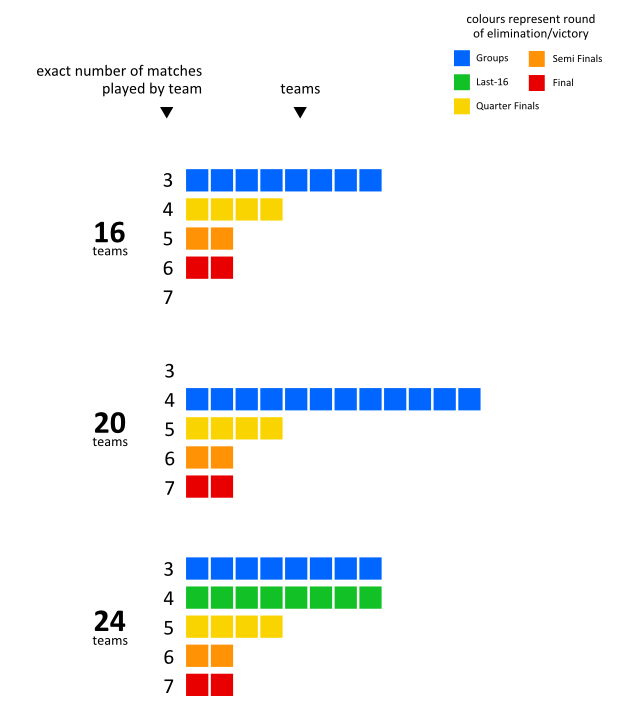Why not 20 teams, UEFA?

The qualifiers for the European Championship are approaching their end and they will have soon completed the guest-list for the 16-team party that is the final tournament – probably for the last time. The format of four groups of four, which was first used at Euro ’96, is being replaced and 24 teams will assemble into six groups of four in France in 2016. This expansion brings with it criticism that the quality of the tournament will inevitably decline and that no ties between great teams will occur until after many finals matches have been played. Following disappointing performances from many countries at Euro 2008, some argue that 16 teams is already too inclusive. Greece’s surprise success at Euro 2004 does not show the value of including more teams as strongly as it might appear to – Greece beat Spain to the top of their preliminary group and would have qualified had there been as few as 12 teams in the finals.
If UEFA is adamant on expansion, and had they not already settled on 24 teams, I would suggest a move to 20 teams drawn into four groups of five, with the top two in each group progressing to the quarter-finals. This is the format that is currently used in the Rugby World Cup, but I am not suggesting that football replicate Rugby’s bonus points – an extra point awarded for scoring more than four tries, losing narrowly, trying your hardest or doing a really nice haka – just the number of groups and teams.
Here you can see the proportion of UEFA’s teams that would take part in 16, 20 and 24-team tournaments. Below that is the current proportions that take part in the continental championships of the confederations that are of comparable size to UEFA. For completeness’ sake I’ve thrown in the equivalent figures for South America and Oceania as well as the proportion of FIFA’s teams that the World Cup caters for.

Even a 20-team tournament makes UEFA a more inclusive confederation that any other with more than a dozen full members. A finals with 24 teams may well take ‘the more the merrier’ a bit too far.
I feel that there are a number of advantages to a 20 team tournament:
- As the mathematicians among you will have realised, 20 is equidistant between 16 and 24 so it offers an even compromise between maintaining quality and getting more teams involved.
- It does not involve the four best third-placed teams advancing from the group stage, something that is needed to whittle 24 teams down to 16. The best third-placed teams progressed in the 1986 to 1994 World Cups and still do in the Copa America, among other tournaments. To me, this format, that leaves teams waiting on the outcomes of other groups, is awkward and should be avoided if possible.
- Unlike the move to 24 teams, which makes the group stage worryingly less competitive (67% of teams advance), a 20-team group stage is actually more competitive (40% advance) than the current 16-team format (50% advance).
- It offers a change to the four-team groups that we see in so many international football competitions. The World Cup, most continental championships, football at the Olympics and the Confederations Cup all use four-team groups. There is nothing much wrong with four-team groups – aside from maybe being so small that they often end up panning out in a similar way as each other – but a bit of variation from them would be nice.
- Every team plays at least four matches rather than three. A major motivator for having any kind of group stage as the first round is to guarantee every team a decent minimum number of matches. This makes it worthwhile for fans to travel to the host country and mass excitement to be built up even for teams that are expected to be eliminated at the first stage. A five-team group increases every qualified team’s minimum level of participation by 33%.

Here are some disadvantages to a 20-team format:
- A feeling that I sometimes get during the World Cup is that it seems an awful misallocation of matches to have three matches per team to sort out the best 16, but only one match per team to sort out the best 8, 4, 2 or 1. In 2010, Brazil and Argentina both had exciting teams but hadn’t been really tested until the quarter-finals, whereupon they both lost and were immediately knocked out. I felt that they were still getting started and deserved another chance to prove themselves. In short: why were six matches played to sort out the best two from the uniformly dyer Algeria, England, Slovenia and USA but only two to sort out the best two from Argentina, Germany, Brazil and the Netherlands?
I have absolutely no idea how to format a competition that maintains a minimum of three matches for each team, gives more matches to the later rounds, maintains excitement in the later rounds and could be played in the space of a month. It almost certainly does not exist. The four-groups-of-five format would make the allocation of matches to importance even worse with 40 out of the 47 (85%) matches allocated to the first round, compared to 24 of 31 (77%) in four-groups-of-four and 36 of 51 (71%) in six-groups-of-four.

- Finally, and probably crucially, a final tournament involving 20 teams means less income for the organisers than one with 24 teams.
What do you think; 16, 20 or 24? Or do any other integers take your fancy?

Very interesting. Particularly like the point that fewer teams progress from a 5-team group, thus creating competition. The Copa America showed that if you have a decent chance of going through, you’ll make sure you get everything right at the back first, even if you’re a relatively average team.
Clearly there’s the incentive to win matches under a 20-team format. No harm in that.
About the first disavdantage, how about a second group phase? The good point for fans is that there would be more matches. The bad point for players is that there would be more matches, too.
I really like these kind of articles.
Very interesting piece and something I have often considered myself. In the Spain World Cup of 1982, 24 teams were placed in six groups of four and the top in each qualified for a further group stage, consisting of four groups of three teams. The winners of each of these four groups went through to the semi-finals.
So in one way (particularly in the mini-group made up of Argentina, Brazil and Italy) you had the best teams playing multiple games to establish the strongest.
There are plenty of disadvantages though – one of the three teams would always complete their two games before the others, giving them an advantage to know what they need to do, or – if the first team wins both its games – creating a dead fixture between the other two in what would be the latter stages of the tournament.
With the four groups of five model, dead games could also be a problem. Lose your first two games and you’re all but out (barring a miracle), leaving you to play two more (dead games) and remain in the country for another fortniht or so with little chance of progress. Torture.
Simple solution is to retain 16-team structure. Clean and uncomplicated… who would have thought that UEFA would eschew such straightforward logic, eh?
Second line should read … top TWO in each group…
Apologies.
Very interesting piece. I would have previously written off 20-team competitions, based on the Rugby World Cup 2011. Why?
If you lose your first games, you’re almost definitely out (thanks Kingswell). This reduces excitement – contrast that with the last day of competition in Group F (Paraguay/Slovakia/Italy/NZ) where an unlikely result knocked the Italians out, and the NZ team went into their last game with the hope of second round qualification through a draw or win.
Another issue is that the group stage seems to go on forever… the proportion of knockout games is very low in comparison with 16 or 24-team finals.
I’m now not sure these are such an issue in football. The main reason is that the level of skill between teams varies less, and so the likeliness of ‘upsets’ – wins or draws – rises a lot. In the modern era, there are no World Cup football equivalents of Namibia (4 World Cups, 100% losses) or even Russia.
The only issue is the small number of teams – 40% – that make it to the second round. But that might be a better figure than 67%…
Meant to put this in my first post…
@ongoalsscored: would you say that the advantages of a 20-team competition – and number of competitors in the football World Cup as a proportion of FIFA members – is justification for a 40-team World Cup?
It seems one way of having our cake and eating it – in terms of giving successful confederations (i.e. South America, Europe) extra places while continuing to expand the number of place for Asia/Africa/etc…
I agree that groups of five come with their own set of problems – less consistency in gaps between matches for different teams as well as the ones you mention – but avoiding the best 3rd placed teams nonsense is invaluable in my opinion.
I wouldn’t be in favour of expanding the World Cup. There are always a fair few weak teams in the 32 but reducing it would make it too exclusive (and it would probably get cut back to the dreaded 24!), so I think it’s just right as it is.
Sadly, none of this was factored in, I expect. The proposal was made by the Scottish FA, and agreed by nearly everyone. The smaller FAs saw a chance to get to the land of milk and honey, and the larger ones knew that not even they – I’m thinking England here – could fail to qualify, which if you’ve got 20 years of repayments for Wembley is a major boon. There was no-one around the table to say anything about quality…
I’ve been thinking, if you’ve got 24 teams, why not 8 groups of 3? with the top two going into a round of 16. 39 games total. Less dead rubbers in the group.
“It does not involve the four best third-placed teams advancing from the group stage, something that is needed to whittle 24 teams down to 16. The best third-placed teams progressed in the 1986 to 1994 World Cups and still do in the Copa America, among other tournaments. To me, this format, that leaves teams waiting on the outcomes of other groups, is awkward and should be avoided if possible.”
And so you suggest groups with 5 teams??? LOL and Haha
Thanks, thanks – I’m here all week.
Are you saying that groups with odd numbers of teams are awkward because it takes a long time to play all of the matches and the teams’ rest periods are unequal?
If so, I definitely agree that those things are undesirable, but I still say that the best-third-place arrangement should be avoided at all costs.
You could make 4 groups of 5 with the winners of the group advancing to the quarter-final.s The second place and third place teams qualifying to a knockout round before the quarter-finals. Then the 4 winners of this knockout round progress to the quarter-finals to complete the 8 teams.
In other words, 12 teams advance from the group stage but the group winners get a bye to the quarter-finals
Could an option be a straight knock-out round of (say) 32 seeded teams reducing to 16 teams, then a group stage round of 4×4 teams., with the top two from each group going through to a quarter final. Then straight knock-out. Any takers?